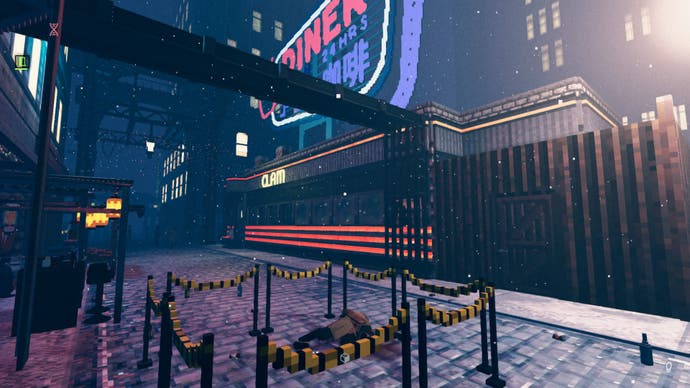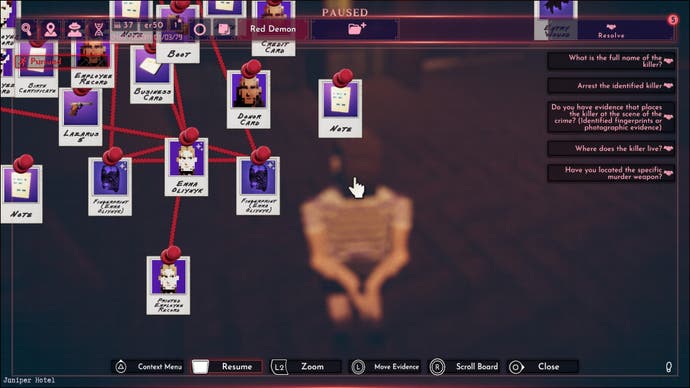Shadows of Doubt review - an unmatched detective simulation, when it works
Caprice procedural.
Better strap in folks, this killer thriller has a few twists in the tale. Shadows of Doubt is, on paper, my dream game, a detective simulator where you solve procedurally generated crimes through a combination of Obra Dinn-esque deduction and Deus Ex style infiltrations. In a fully simulated city of hundreds of citizens, you solve thefts, murders, and kidnappings by legally or illegally entering homes and offices, scanning for fingerprints, searching for clues, and cross-referencing dizzying amounts of information to track down the culprit.
It sounds impossible, more so when you know it's mostly developed by one person. And yet, having played it multiple times during its Steam early access alpha, I know that it works. Sure, the alpha could be glitchy, quirky, and more than a little buggy. But when it came together, Shadows of Doubt was magic.
All the review version needed was a big lick of polish and a bit more variety in the murders, and you'd have a potential five star game on your hands. Unfortunately, my experience with Shadows of Doubt 1.0 is the worst I've had so far. This is partly down to spending much of my time with the PS5 version, which is unquestionably the lesser variant of the game. But there are also broader issues here, from new features that I don't particularly like, to parts of the experience that are outright broken.
That said, let's start with the good stuff, because there's plenty to discuss. Shadows of Doubt begins with you creating your own detective and dropping them into a city that is either picked from a handful of presets or generated from scratch. These cities always blend 1950s noir fiction with cyberpunk retrofuturism and a sprinkling of British landmarks (like big red phoneboxes) but everything else about them is algorithmically assembled.
And when I say everything, I mean everything. The buildings, the apartments and offices inside those buildings, the people who work and live in those establishments, the names of those people, their individual occupations, their relationships, phone numbers, bank statements, tenancy agreements, medical records, email inboxes, fingerprints, blood types. Every citizen is even assigned a specific type of handwriting, which you can cross-reference in address books, letters, or ransom notes they may have sent.


Viewed purely as a social simulation, Shadows of Doubt is a remarkable achievement, perhaps the closest anyone has come to realising Warren Spector's fabled 'One City Block' concept. Into this meticulously assembled society your sleuth spawns, homeless, jobless, and virtually penniless. Fortunately, there's plenty of work for a P.I. with light pockets and loose morals, from identifying and arresting suspects on behalf of one of the local enforcement agencies, to vandalism and corporate espionage.
These jobs exist to help you fill your coffers, but also to pass the time while Shadows of Doubt arranges the boards of its centrepiece cases. See, the game's major crimes, the murders and kidnappings, play out in real time, which means you have to wait for them to happen. When they do, a call comes in on the wire, accompanied by a dramatic title card. This is followed by a less dramatic period where you head to the Town Hall to pick up a deflatingly bureaucratic Case Resolution Form (more on these in a sec), but then the case is, officially, afoot!
While thematically trite, these Resolution forms provide the backbone of the mystery, asking a series of questions which you need to answer. Things like "Whodunnit? Where do they live? What weapon did they use?" You don't have to answer every question to solve a case. But the more you can answer, the richer the reward.

How you approach each case is entirely up to you, but typically you'll start by investigating the crime scene, searching the body and the surrounding area for clues. This is achieved primarily through a specific interaction called "Inspect", which creates a 2D case file of any object or piece of information you use it on. This file can be pinned to your detective's mental corkboard, which exists in a separate menu. Here, you amass and organise clues and evidence for your case. Moreover, files may also provide further information to help you solve the crime. For example, inspecting a victim's wallet may reveal their name and home address, all of which can be pinned to the board individually. You can also steal their cash, just like a real wallet inspector!
Gathering information in this manner represents one half of Shadows of Doubt's play. The other half revolves around finding ways to access this information. As a private investigator, you have no legal right to impose your investigation on other people. If you want to, say, snoop around the apartment of the victim or their associates, you must either ask permission from the residents, or sneak in when they're out by picking the lock or finding an alternate entrance. Doing this is, of course, illegal, and comes with the threat of fines, detainment, or if the situation turns hostile, an expensive trip to the hospital.

In short, Shadows of Doubt is a game about breaking the law in search of justice, where you skulk around places you shouldn't be scanning for fingerprints, rifling through bins, and hacking computers for clues to crack the case. And by Chandler's typewriter, that combination can be gripping. The possibility space feels enormous. Each building has a security room, for example, which you can break into to access the structure's camera feed. Basements, meanwhile, house the building's phone system, which you can tap into to access call records. Every office keeps employment records that you can rifle through, and every employee has their own desk with their own computer terminal.
All of this amounts to an environment that is ripe for emergent storytelling, that convincingly replicates the highs and the lows of being a private detective. I've cracked numerous cases through canny investigation and bona-fide Eureka moments. But I've also solved just as many through old-fashioned shoe-leather and door-knocking. I've sat with a bourbon in a local dive bar as I pored over case notes, and I've stewed in the mouldering armchair of my dingy basement apartment, cogwheels spinning like the Tasmanian Devil. I've been reduced to stealing money from the apartment of victims, and running through the street asking random citizens "Do you know this person?!" In that last example I was genuinely desperate, yet just when I thought all was lost, I stumbled upon the partner of the man I was looking for.


Combined with the aesthetics and atmosphere of the city, Shadows of Doubt can be astonishingly evocative. When you're trudging through the rain between apartment blocks, or searching a body lying in the snow, or hiding in a cupboard because the person whose apartment you're searching just woke up - all with the soundtrack's grungy synths buzzing in the background - no other detective game comes close to capturing both the mood and methodology of noir fiction. But the game does not consistently operate at this level. It's usually a wonkier experience than that. Often this is in a way that's amusing, such as a citizen slipping on a wet pavement before yelling "I need a lie down!" or that one suspect who refused to so much as tell me her name, but gladly provided her fingerprints, the exact evidence I needed to prove she was the killer.
Sometimes, though, Shadows of Doubt's idiosyncrasies are less fun. Stealth is haphazard, because NPCs operate on logical behaviour patterns rather than set patrols. If you turn a light off, for example, they will always try to turn it back on, which makes logical sense, but makes sneaking around extremely difficult. A bigger problem though, is that the simulation sometimes gets in the way of its own crimes. Once you've solved a major case, the time between getting a new one could be anything between half an hour and, well, forever. I've generated several cities where murders simply stopped happening, and believe me, this had nothing to do with my detective skills. In such instances, I assume something prevented the game-assigned murderer from reaching their selected target. But from the player's perspective, the central premise of the game has essentially ceased functioning.

There are larger problems still. As I mentioned, most of my review time was spent with the PS5 version, and the porting job is basic to say the least. Not only is most of the text on the caseboard illegible from any distance (there is an option to switch the font type for some files, but not all), the controls scheme is not suited for a pad at all. Managing the caseboard with buttons and a thumb-pad is painful, and even in general play you're constantly pressing the wrong buttons or pulling the wrong item from your inventory. Calling an elevator, bringing up the button panel, and selecting the floor you want requires three entirely different inputs. Again, there's logic behind those differences, but that doesn't make them any more intuitive.
The biggest disappointment, though, are the kidnappings. Kidnappings are a new major case type that alternate with murders. Instead of looking for a killer, you're looking for both the victim and the kidnapper, starting from a ransom note left in the victim's apartment, and proceeding with the investigation from there. Or at least, that's the idea. In every kidnapping case I played, the ransom note was handed to me by the (handcuffed) kidnapping victim in their own apartment, as if the kidnapper had forgotten the whole 'kidnapping' part of kidnapping.
This is obviously a bug of some sort, but I'm generally not sold on these kidnapping cases. They have a timed element to them which I don't think suits Shadows of Doubts more methodical pacing. This might make more sense if kidnappings were reserved as a higher-level case type, but a kidnapping case can be the first investigation you receive in a new city, a big ask when you've got no money and no knowledge of the town. Also, while I've never expected Shadows of Doubt's cases to generate perfect mystery narratives (motive is something the game generally glosses over) some of the kidnapping stories really made no sense. In one example, my victim was "kidnapped" by their doctor who was running illegal medical experiments on them in an underground lab. This would make sense, were it not for the killer sending a ransom note in the first instance.
Ultimately, Shadows of Doubt doesn't work as well as it could. Then again, the fact that it works at all is an enormous achievement. Like the quintessential hard-boiled detective, Shadows of Doubt is unstable, abrasive, and at times, borderline broken. But it's also singular of focus, dogged in pursuit of that goal, and when all the pieces click into place, undeniably ingenious.
A copy of Shadows of Doubt was provided for review by Fireshine Games.



